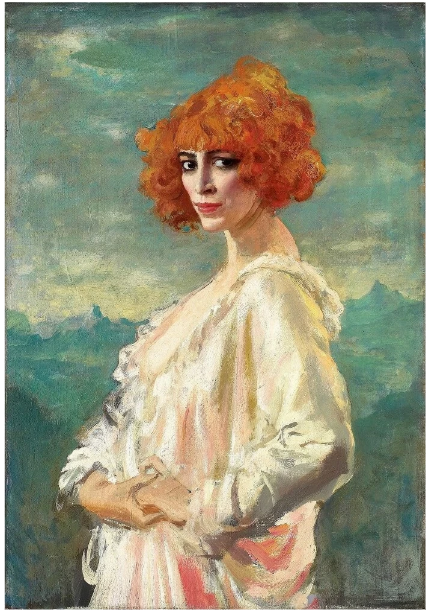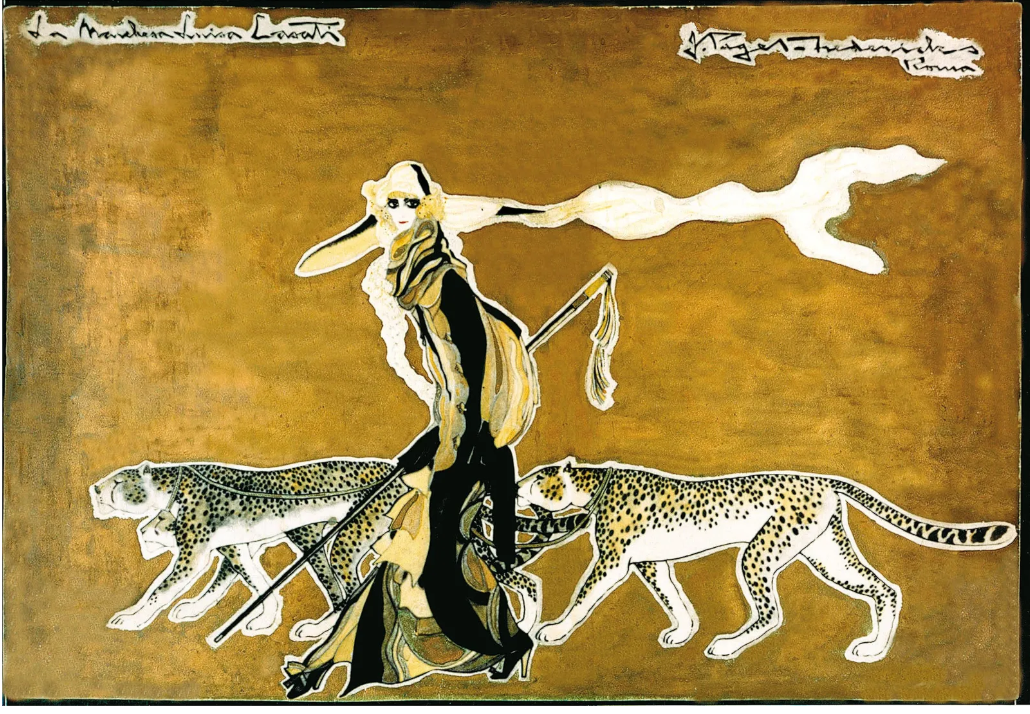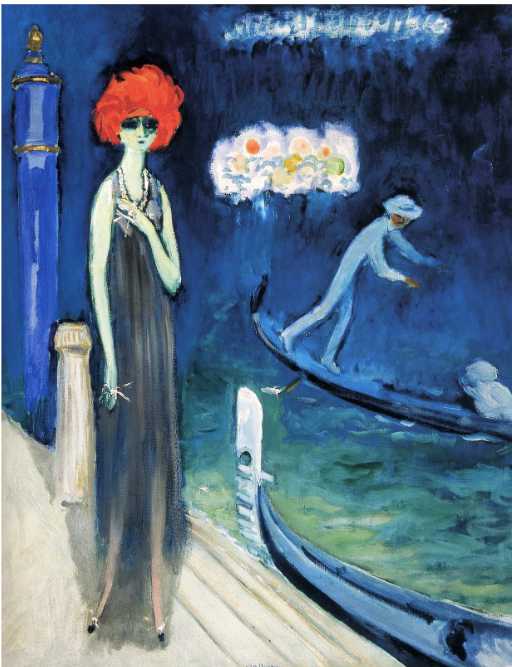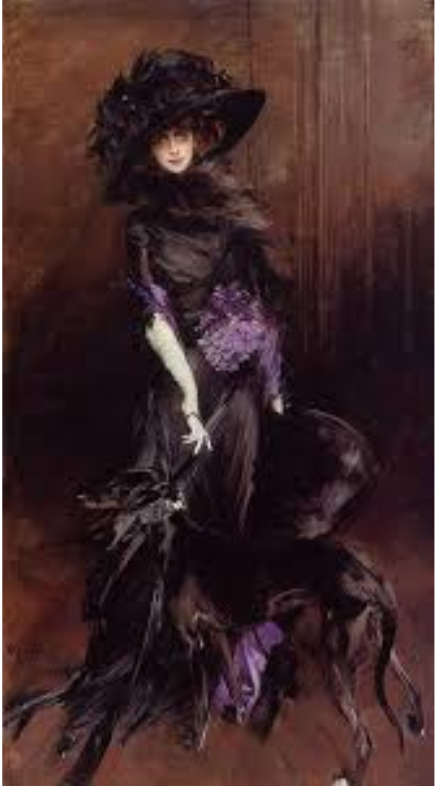Augustus John's take on the Marchesa
Continuing our parade of women who broke their crinolines climbing over the garden gate, much like our primping, preening, flapper, sister-in-spirit, Maisie Gray from The Washashore—out this June (preorder now!) I give you one of the most enchanting, and cruelest, muses of the 20th century. Born in Milan to a count and countess, Marchesa Luisa Casati entered the world the same year Gladys Deacon fell to earth, in 1881.
Luisa was orphaned and rich by the time she was a teenager and spent the rest of her life making herself into a living work of art and, therefore, in her estimation, immortal (she wasn’t wrong). Half a century later, fashion designers like Karl Lagerfeld, Dries Van Noten, and John Galliano pay her outré appearance homage with sylph-like models in towering headdresses.
A Galliano creation, left, and Karl Lagerfeld, right
The Marchesa wasn’t exactly overlooked in her own time. Ever the ethereal alien, Casati was painted by Giovanni Boldini, Augustus John, Romaine Brooks, Kees Van Dongen, and Ignacio Zuloaga; sketched by Drian and Alastair; sculpted by Giacomo Balla and Catherine Barjansky; and photographed by Cecil Beaton, Baron Adolph de Meyer, and, of course, Man Ray. The list of those whom she infuriated, intimidated, or inspired goes on and on.
Augustus Edwin John 1919
Dubbed the original female dandy, Marchesa Casati was six feet tall topped with a fiery mop of orange hair, cheekbones sharp enough to carve marble, and eyes deepened by belladonna and miles of lashes. As Judith Forman puts it in their 2003 article in The New Yorker, “The Marchesa was exceptionally tall and cadaverous, with a head shaped like a dagger and a little, feral face that was swamped by incandescent eyes.”
The Marchesa in 1922 by Man Ray
Casati augmented her odd looks as much as she could, painting her eyes darker to give them more mysterious shadows and wearing headdresses to give her stature another six inches. And if she was wearing clothes, which wasn’t frequently, they were always the very best. Stylish to the end, Casati was buried in a leopard coat with falsies on her lashes and a favorite stuffed Pomeranian at her side.
In her inspired youth, Luisa torched a fortune on her looks and lifestyle. She would wear a drugged boa constrictor painted gold around her neck (scoffing at any feather boas she saw, I’m sure). She was wearing her living necklace when she checked into the Ritz in Paris, until the snake sobered up and made a break for it.
Other pets included cheetahs and borzois walked on diamond leashes at midnight across St. Mark’s square (close to her Venetian home on the Grand Canal) wearing only a fur coat and jewels. Every room she stalked into, Luisa dazzled.
The Marchesa by Joseph Paget-Fredericks
At one ball, she wore a crown of peacock feathers slick with fresh chicken blood. At another, she shocked Paris with her version of bracelets: live snakes coiled around her arms. Dinner parties were no less theatrical. Guests dined beside life-sized wax mannequins of Luisa herself, complete with glass-green eyes and wigs made from her own flame-colored hair. She may not have been the warmest hostess, but she was certainly the most unforgettable.
Whilst living for a summer on Capri (as one does), the Marchesa dyed her hair green, wore only floor-length black dresses with long, elegant trains, and instructed her servants to throw copper shavings into the fires when she entered rooms so that the green flames would match her hair. I think this sounds like a solid path for any pixie dream girl with a wad of cash.
Working for Marchesa Casati wasn’t always a thrill. She almost killed one of her servants when she painted them with gold leaf in some of the hottest weather in the country, leading to a near-fatal heat stroke and a close brush with death. The man was only saved by a doctor's intervention.
Marchesa Luisa Casati in The Quai, Venice by Kees van Dongen, 1921
Like many who inherited obscene amounts of wealth at young ages, Luisa Casati did not plan well for her future and burned through her enormous fortune, spending her cash on jewels, gowns, art, parties, exotic pets, and every other indulgence she adored.
Similarly to the Duchess of Marlborough, Luisa Casati scorched the atmosphere on her rapid decline and disappeared into a poof of poverty. By 1930, she was up to her belladonna-ed eyeballs in debt, to the tune of $25 million in today’s dollars. That’s a staggering tab for cathedral trains, fake lashes, and diamond dog collars.
Her end was as pitiful as her beginning was opulent. After liquidating everything she owned to cover her towering debts, Marchesa Casati faded into a dingy bedsit, muttering curses, giving occult readings, and mailing her taxidermy bills to her beleaguered granddaughter. There’s a lesson in her white-hot streak across the firmament: brilliance without ballast burns out fast. Casati wasn’t built for endurance; she was all spectacle, no spine. A masterpiece of illusion, until the curtain fell.
-MH
The Marchesa by Boldini







